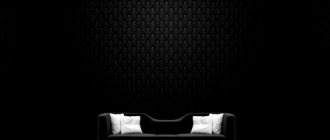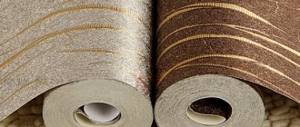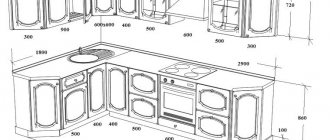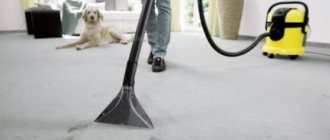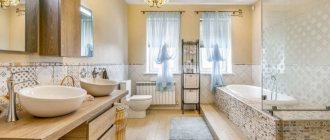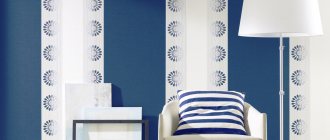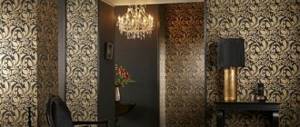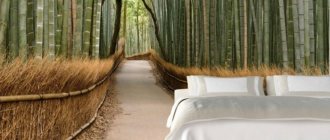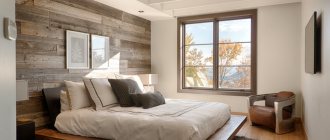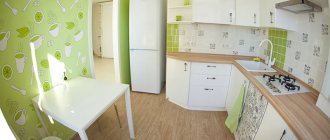But the correctness of creating such a design will depend on how skillfully you handle textured coatings: it’s no secret that relief patterns or the rough surface of the walls can have a special impact on the perception of the interior.
Let's find out how to achieve a positive result, and also figure out what wallpapers of different textures modern manufacturers can offer us.
Features of embossed wallpaper
As a rule, most textured wallpaper for walls consists of two or more layers: this structure allows manufacturers to create a visible pattern or relief without compromising the strength and quality of the material .
Many wallpapers of this type are created by pressing natural materials (for example, wood chips): depending on the specifics of such procedures, coatings with large, medium or fine-grained textured elements are obtained.
Attention! Wallpaper with a textured pattern is an ideal option for masking wall surface defects. The degree of expression of the texture directly determines how carefully you hide the unevenness and cracks of the base.
Another feature of using textured wallpaper in the interior is the possibility of creating a seamless wall design . In particular, this possibility is typical for rough coatings: wallpaper with large relief images will have to be carefully joined to each other to create a complete pattern.
Undoubtedly, this type of embossed wallpaper for walls has decorative advantages over standard wall coverings, but it is worth highlighting the practical properties of these materials: they are environmentally friendly, capable of transmitting air and moisture , i.e., hygroscopic, and also have anti-allergenic properties .
The process of gluing canvases of this type does not cause any particular difficulties: for impregnation, the wallpaper is treated with glue and left for 10 minutes, and then glued to the surface of the walls. This process is required, since the multi-layered relief fabric may not be sufficiently fixed to the wall.
When choosing the right wallpaper of this type, consider the following recommendations:
- Wallpaper with a large and pronounced relief can visually reduce the space , so you should not use such coverings for the design of cramped rooms;
- when combining textured and standard wallpaper, maintain a harmonious style : catchy designs in combination with texture should not cause discomfort;
- some types of textured coatings may deteriorate after thorough cleaning, so take into account the properties of the material when gluing wallpaper in places prone to contamination ;
- a combination of several textures in the interior can cause difficulties in joining and masking irregularities. This deficiency can be corrected using decorative moldings .
To ensure that the texture of plain wallpaper meets your expectations for practical and aesthetic properties, check out the existing varieties of such wall coverings.
Liquid
Liquid wallpaper contains cotton, silk or cellulose, this allows you to create an interesting surface texture. In many ways, such a coating can be compared with textured plaster, but in the case of wallpaper, everything is much more convenient, simpler, and sometimes cheaper. Before use, the mixture is diluted with water, so it acquires a pearlescent or glossy tint. You can apply the finished composition to the wall surface either with a spatula or with a gun; in the latter case, you can achieve greater relief.
The most important advantage of liquid textured wallpaper is the creation of an absolutely seamless surface; thanks to its special structure, you can easily mask small cracks and pits on your own.
Types of textured coatings
If you think that wallpaper without texture will not be able to reveal your idea, then you can opt for the following types of wall coverings:
- vinyl;
- non-woven;
- paper;
- liquid;
- fiberglass wallpaper.
The texture of vinyl-type wallpaper, as a rule, is not pronounced. Such wallpaper consists of two layers: the main one (paper or non-woven) and the outer one, made of durable polyvinyl chloride . The exception is embossed profile vinyl wallpaper on a paper base: here the relief texture is quite clearly visible, which is why they are often purchased for subsequent painting.
The rough surface of vinyl coverings allows you to create a sophisticated and pleasant room design. One of the main advantages of such materials is the ability to clean them .
Non-woven textured wallpaper is created from compressed fiber. Such coatings are characterized by high strength and wear resistance, resistance to mechanical damage and elasticity of the material . However, the patterned design of such wallpaper must be treated with care: if used carelessly, it can be damaged.
Tip: to increase the durability of such wallpaper, use paint. Textured non-woven wallpaper for painting will be more durable and resilient, and coloring materials and moisture will not spoil the structure of the canvas.
Fiberglass wallpaper is also made on a paper base, which facilitates the process of gluing and removing from the surface. Wallpaper of this type with a pronounced relief pattern is presented in the largest assortment, since the fibers create different textures depending on the characteristics of the weave .
The characteristic features of fiberglass coatings include the ability to mask uneven walls, resistance to fire, moisture and detergents, durability and strength .
The texture of embossed wallpaper for walls made of paper can also be subject to negative influences. But wallpaper of this type is most suitable for those who value simplicity, safety and lightness of materials .
Although they do not have the same long service life as other wall coverings, if used carefully they will last quite a long time .
To create a textured theme, such wallpaper is made in two layers, so the strength and wear resistance of these coatings is much higher than standard paper wallpaper for walls. In addition, paper textured materials can withstand moisture and can be dyed .
Liquid textured wallpaper is a special type of wall materials. To produce liquid wallpaper, cellulose is used, and the finished material looks like a loose mixture, which, like plaster, is applied to the surface of the walls.
The shade of such wallpaper is selected initially: the mixtures are pre-painted in different colors , so additional decoration of your walls is not required.
Almost all wallpapers of this type today include recycled materials . Waste paper, sawdust and other natural materials create an unusual surface for such wallpaper for walls, but do not impair their quality properties.
It doesn’t matter what kind of wallpaper you decide to use to decorate your rooms - grainy, wavy or with thematic scenes - in any case, the interior will become more advantageous from such an idea.
Relief paper coverings
Beautiful, high-quality textured wallpaper for walls can be chosen not only in the elite, but also in the budget category. These coatings are widely represented in the group of paper finishing materials. Despite their low cost, they have excellent aesthetic properties. Such coverings can be used in the design of living rooms, bedrooms, children's rooms, and offices. They may have two or three layers. If you need to mask defects on the walls using wallpaper, preference should be given to three-layer options.
Textured wallpaper in dark shades
Several technologies are used in the production of paper embossed wallpaper:
- embossing;
- use of additional raw materials;
- application of foamed polymer.
By means of embossing, any patterns and ornaments, including complex ones, with a large number of elements, can be created on canvases. In this category you can choose textured wallpaper for painting . These materials undergo special impregnation, which imparts water-repellent properties.
Auxiliary materials can be used to create reliefs. For the most part, wood shavings are used for this purpose. It is randomly poured onto the base and covered with another layer. The result is an original, chaotic drawing. Designers often use these coatings in modern styles.
Vinyl textured wallpaper
A pattern can be created on paper webs, a pattern made from foamed polymer. The result is extraordinary, durable, beautiful finishing materials that can decorate any interior.
Wallpaper texture for painting
Special attention should be paid to embossed wallpaper with the possibility of coloring. It's no secret that paintable wallpaper without texture is much easier to paint . The textured surface of such coatings allows you to create unusual wall designs, since decoration is possible in several ways.
The first - and most common option - is external painting of the canvas . Using a roller or brush, paint is applied directly to the textured design.
The second painting option involves applying coloring agents to the inside of the wallpaper : then the outer pattern or design will retain its original color and will stand out against the colored background. This painting technique is most often used for non-woven wall coverings.
Initially, almost all wallpapers of this type have a light shade. White textured wallpaper is easier to paint in the desired tone . Moreover, wallpaper of this shade looks elegant and stylish even without further processing: just choose a surface on which it will not look out of place.
Paintable wallpaper with a textured surface can have a different base : paper, fiberglass, non-woven and others, so you don’t have to waste time looking for a material that matches the specific conditions of the room you are decorating.
Textured wallpaper is painted using dispersion or water-based paint compositions.
We also recommend that you find out which wallpaper for painting is best to use, as well as read about the prices and paint consumption for wallpaper for painting.
Vinyl wall trim
One of the advantages of vinyl is its ease of processing. Hot and cold stamping is used for this material. The choice of design is unlimited. You can find materials decorated with:
- ethnic ornaments;
- flower arrangements;
- abstraction;
- geometric patterns.
Coatings that imitate natural materials are especially popular now. Vinyl textured wallpaper imitating wood , stone, brick accurately copies these surfaces. At the same time, a spectacular, fashionable finish will not require significant costs.
Textured wallpaper for painting
The embossed vinyl layer can have a paper or non-woven backing. The cost of the material and its properties directly depend on this factor. If leveling the walls is not required, you need to save repair costs, you can choose paper coverings. Vinyl will provide the finish with strength, durability, and ease of maintenance. If you need to hide defects or provide a room with noise protection, you should give preference to canvases with a base made of non-woven material.
The polymer layer is waterproof and can be washed using household chemicals. You can use vinyl textured wallpaper for the kitchen , hallway or bathroom without fear for their integrity. They practically do not fade, and even in direct sunlight they retain the brightness of their shades.
Textured wallpaper for painting
Wallpaper with imitation
Wallpaper that imitates various materials looks original in interiors of any stylistic direction. For example, textured wallpaper that imitates brick is suitable for decorating interiors in loft or modern style, imitation wood for Provence or country, and plaster for classic interiors.
Textured brick wallpaper is considered one of the most original design solutions. With the help of such coatings you can decorate entire walls or individual areas in the room .
For example, in the kitchen, embossed wallpaper with a brick texture can be hung in the dining area or above the set instead of an apron. In the living room, brickwork will be a stylish decoration for ledges and niches. In the bedroom, such wallpaper can be pasted in the bedside area, and in the hallway - opposite or next to the front door.
Tip: imitation brickwork looks most harmonious next to the fireplace: such wallpaper will emphasize the aesthetics and nobility of the living room design.
Textured wallpaper with a stone look will play similar functions in the interior. Imitation wood is a suitable option for interiors stylized with a natural theme. Wallpaper with a texture similar to leather upholstery or animal skins is best used as accents in modern interiors.
One of the most unusual texture solutions actively used in design is imitation plaster . Wallpaper with a plaster texture can come in several varieties. They can be rough, voluminous, or imitate a stone base.
To add antique luxury to the design of the room, you can use wallpaper stylized as Venetian plaster. They can have many rich shades.
Unique linkrust decor
Not everyone knows what textured wallpaper linkrust is. These are elite, luxurious wall coverings; they are produced only with a relief texture. The finishing is created on a paper basis. For the textured layer the following are used:
- chalk,
- rosin,
- wood flour,
- wax.
Textured wallpaper
To create reliefs, special stamps in the form of rollers are used. The design uses fancy, complex patterns, ornate curls, characteristic of the Victorian era. These textured wallpapers are available for painting . The canvases have a neutral beige tone.
These coatings are not used to cover all walls. With their help, a certain area in the room is highlighted, they are combined with ordinary canvases. The use of linkrust adds notes of royal grandeur and sophisticated chic to the design. Typically, such coatings decorate the designs of elegant living rooms, classic bedrooms, and respectable offices. Catalogs of textured wallpaper for walls offered by leading brands will help you find such materials
Wallpaper for plaster
These are environmentally friendly materials and provide high-quality air circulation. The strength of linkrust wallpaper increases over time; it retains its integrity and beauty for many years.
Application in design
Despite the fact that many photos of textured wallpaper show us successful examples of creating designs with such coatings, it is not always possible to create a harmonious atmosphere due to pronounced textures.
Since any accent in the interior must correspond to the purpose and functions of the room, let us dwell in more detail on the features of textured decoration of some interiors:
- In the bedroom you should give preference to wallpaper with a barely noticeable texture. Pronounced three-dimensional designs can create visual overload in such an interior. One of the most successful options for a bedroom is wallpaper with a pleasant rough texture, painted in a light tone. Accents can only be used in the bedside area of the room;
- When decorating a living room, you can choose a more pronounced patterned relief. These can be geometric designs, large classical ornaments or strict strokes that create an atmosphere of rigor and restraint. The lighter the shade of textured wallpaper, the more spacious the room will become, so leave dark wallpaper of this type only for some areas in the space;
- The kitchen is one of the interiors where you can give free rein to your imagination. The texture in the cooking area should not be too voluminous: here it is better to hang wallpaper with lines or checkered patterns that have a poorly defined texture. But in the cooking area, with the help of textured coatings, you can create powerful accents, emphasizing the design features with rich shades of both light and dark palettes;
- Since the hallway is the first room in the house, it needs to provide the right impression. Textured wallpaper will cope with this task better than other coatings, especially if you give preference to materials with imitating properties. If you have a spacious hallway, you can use bright and dark accents. A hallway with a small area should be as bright as possible.
Do you want your interior to look elegant? Wallpaper with texture is the best solution.
Textured wall coverings are very popular because they not only provide protection for the walls, but also make them more stylish and sophisticated. If you have not yet decided on the design of your home interior, look for interesting texture options, and your room will certainly become more lively and interesting.
